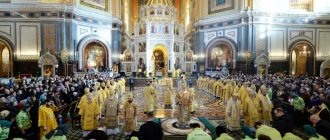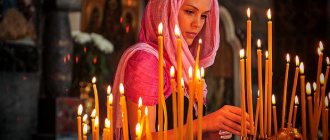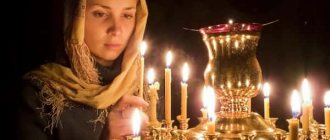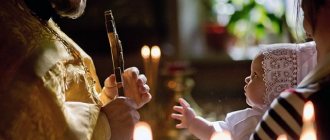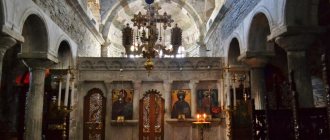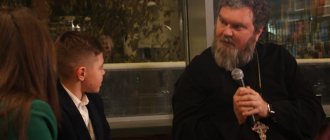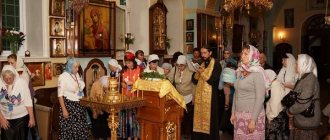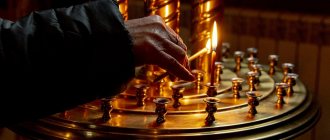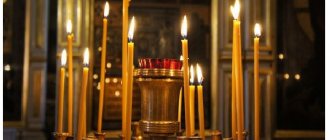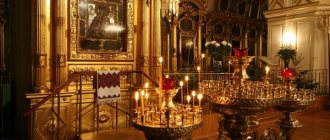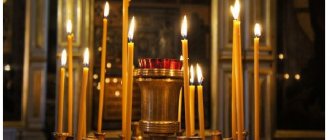Prayer in an Orthodox church
Church prayer is the common prayer of all parishioners
Worship in the Orthodox Church: charter, meaning and order
When the sign of the cross, prostration and bow to the ground are performed
How to pray in front of an icon in church
Church Slavonic language - meaning and role
Photo: Patriarchia.ru
History of icons
Church traditions say that the first icon was painted by the apostle and evangelist Luke. He depicted on the board from the dining table the image of the Blessed Virgin Mary with a baby in her arms. When the Mother of God saw the creation, she said that the grace of Her Son would always be with this icon. The physician and artist Luke is considered the first icon painter. With his light hand, holy images of the Mother of God, God's saints and martyrs began to be depicted everywhere. The main church holidays were also depicted on the icons. However, with the advent of the first paintings depicting saints, people still did not know how to venerate the icon correctly. Rules for the behavior of believers in front of holy images were established later.
Iconography
Each icon is created in accordance with church canons. This means that the holy image on it must be recognizable and have a transcript of the image or church event. Currently, there are more than a dozen schools of iconography. Each master has his own signature style. Icon painters say that their work requires enormous dedication. After all, before the start of creation, during the painting of icons and at the end, certain prayers are read, that is, throughout the entire work of creating the holy image. Therefore, not only the creative approach is important here, but also the spirituality of the master.
Each icon must be consecrated. To do this, certain prayers are read over it, depending on the Saint depicted, and then the picture is sprinkled with holy water. Only after consecration the image becomes Holy.
Where is God: in the temple or in the soul?
Prayer in the temple can be compared to choral singing: while one is singing a note, the other can take a breath, and this will not disturb the overall melody. It’s the same during worship: even if someone is distracted, the other at that moment will be concentrated on prayer, and thus it will not be interrupted. We help each other.
Probably every priest has heard the phrase: “Why pray in church, God is in the soul!” In this regard, I would like to give the following example. You can sit at home and know that there are fragrant apples somewhere, but this knowledge will not help us try these apples. You need to get up, go, find them - and only then can you try. It’s the same with treatment: we all know that there are doctors and medicines, but for some reason no one wants to be treated with this knowledge alone - everyone goes to hospitals and pharmacies.
Rules for applying to icons
When reading a prayer in front of an icon, Orthodox Christians believe that it will be heard by the Saint immortalized on it. And indeed it is.
How to venerate an icon correctly? First, you need to cross yourself twice, then lightly touch the edge of the icon with your lips, and then your forehead. Then move away and cross yourself again. Women must learn one rule: before approaching the icon, you need to remove the lipstick from your lips.
You should not kiss the holy image several times and along the entire perimeter of the glass. Under no circumstances should you kiss the face of a saint. If the icon is “waist-length,” you need to venerate the blessing hand. When painting a full-length painting, you should touch your feet. If a believer doubts where to kiss the icon, it is better to kiss its edge.
In the icon of the miraculous image of the Savior Jesus Christ, the image of His hair should be venerated. When venerating the cross, you need to venerate the Savior’s feet.
How to offer prayers in front of an icon?
God and faith in him are in us, our souls. That is why you need to read prayers not only in a certain place - a temple, but always and everywhere. You can organize the reading of prayers with the help of special religious literature (Prayer Book, Psalter) or in your own words - often this does not matter. The main condition for good prayer is sincerity and a sense of connection with God.
But still, the Church recommends following certain rules. Here's what you need to do to pray at home:
- It is advisable to purchase a collection of prayers - a Prayer Book. It comes in several types - full and short, in Church Slavonic and the familiar Russian language. Therefore, choose a collection of prayers that is convenient for you to use.
- Before praying, you should tune in. This means that it is necessary to drive away all bad thoughts and forget about worldly problems. You should also pay attention to appearance, wear a cross, and women tie a headscarf.
- You need to pray in front of the image of the saint to whom it will be directed. Approach the icon, take a comfortable position, concentrate, bow and cross yourself.
- Say the text of the prayer slowly, out loud or to yourself, thoughtfully, with reverence.
- Prayers should be read daily. Be sure to read morning prayers and prayers before going to bed. This will help you be closer to God.
Is it possible to kiss
Many doubt whether it is possible to kiss icons in church. This is how the church answers this question. In everyday life, people express their love and trust with a kiss. It's the same with icons. When a believer kisses it, he thereby expresses reverence for the image depicted on it.
However, more and more often, people who are far from Orthodoxy are trying to teach others how to behave correctly in church, and are proving that icons cannot be kissed. As an argument, they describe the results of experiments in which fingerprints were taken from icons. Scientists discovered many dangerous bacteria in them, which remained after numerous applications to the icon. However, the priests convince that a believer should not be afraid of this. The Lord protects the parishioners. But as an alternative, it is proposed to simply place your forehead on the edge of the icon as a sign of veneration and reverence for the holy image.
How to enter the church
People who regularly attend church know how parishioners behave in church. However, are their actions correct? Usually the clergy explain how to properly enter the church. So:
- Before crossing the threshold of the church, you need to cross yourself 3 times at its doors, accompanying the actions with bows from the waist.
- Men enter the temple without hats. Women are required to cover their heads.
- Parishioners buy candles and, if desired, order a prayer for health or peace.
- How to dress for church? Men must wear trousers and outerwear that does not expose their torso. For women, the main requirement is a skirt below the knee and also a closed top.
After these actions, believers approach the icons, light candles and listen to the prayers read during the liturgy.
Which icons are approached first?
As soon as believers enter the main part of the temple, a lectern with an icon of the Saint whose feast day is celebrated appears before them. Next to the Holy Image there is a cross. In front of a high quadrangular table with a sloping top, you should cross yourself twice with a bow from the waist, and then venerate the icon and the cross itself.
Which icons should you approach first after the lectern? Here the choice depends on the wishes of the parishioner. For example, you can put a candle for health in front of him. It would not be a mistake if a believer approaches the image of a particular Saint with a request for health and lights a candle there. It is better to find out from the priest which saints help with what, and then approach a specific icon with prayer.
For example, in front of the icon “The Inexhaustible Chalice” they ask for deliverance from drunkenness. Prayer in front of the image of the Healer Panteleimon helps get rid of serious ailments.
You need to remember the dead in front of a special icon. This place is called eve. It is located on the left side of the temple and is a table of 40 candles. You are allowed to remember the dead when leaving the church. One candle is enough for this.
Why do people in the temple pray to icons instead of God?
Priest's answer:
Dear Oksana! In your question, you touched on several different topics that are the subject of Orthodox-Protestant polemics, so I will answer them in order.
- “Why do people in church pray to icons and saints, if the Bible says that you only need to pray to one God: do not make yourself an idol or an idol?”
To more fully sanctify the essence of Orthodox icon veneration, we will divide the answer into several points:
A. Definition of icon and idol.
B. Does the Bible allow sacred images?
Q. Is prayer possible in the presence of an icon?
G. Is it permissible to venerate icons?
D. Does God accept the worship offered to Him through the icon?
A. Regarding the definition of an idol (false image) and its difference from an icon (true sacred image), the Apostle Paul writes about idols: “An idol is nothing in the world” (1 Cor. 8:4). That is, an idol is an image that does not have a prototype. For example: there is a statue of Artemis of Ephesus, Zeus and other pagan gods, but do Artemis or Zeus really exist in this world? - Of course not. An icon, unlike an idol, is an image that has its own prototype. For example: there is an icon of Jesus Christ. Christ is a real Person, like the Son of God - He is co-eternal with the Father and the Spirit. As a Man, after His Resurrection, He ascended to heaven and sits at the right hand of the Father (i.e., His human nature is glorified). There is an icon of the Mother of God, and the Mother of God herself as a person really exists, now being in the kingdom of heaven. So, by definition, it is not correct to identify icons and pagan idols. Pagans honor demons in their idols, while Orthodox Christians honor God and saints in their icons.
B. The Bible certainly allows for depictions of spiritual reality. God, who gave the commandment to Moses: “You shall not make for yourself an idol or any image...” (Ex. 20:4), immediately commands: “And you shall make of gold two cherubim...” (Ex. 25.18), which were on the lid of the ark. covenant. And God promised Moses: “There I will reveal myself to you and speak to you above the mercy seat, in the midst of the two cherubim that are above the ark of the testimony” (Ex. 25:22). The same cherubim were embroidered on the curtain that separated the holy place - the saints from the sanctuary, in the tabernacle of Moses (Ex. 26:1). In Solomon’s temple there were even more of these images: “And (Solomon) made in the oracle two cherubim of olive wood, ten cubits high (1 Kings 6:23). “And on all the walls of the temple all around he made carved images of cherubim and palm trees and blossoming flowers, within and without” (1 Kings 6:29). Although the second commandment, indeed, for the time being, forbade the depiction of God the Creator, for God, in the Old Testament period, did not appear to the Jewish people sensually, and therefore could not be depicted, but only spoke through the prophets.
C. The righteous of the Old Testament prayed in the presence of sacred images: “And I, according to the abundance of Your mercy, will enter Your house, I will worship Your holy temple in Your fear” (Ps. 5:8). The Prophet David, as we see, allowed himself to pray in the temple in the presence of images of cherubim. The Gospel of Luke ends with these words: “And they ( the apostles ) remained always in the temple , glorifying and blessing God. Amen" (Luke 24:53). This means that in the temple they too prayed to God, again, in the presence of sacred images.
D. The veneration of material shrines, including the first sacred images, took place in both the Old and New Testaments. Returning, for example, to Psalm 5, we see that David worshiped the temple. If he worshiped the temple of God, then he also worshiped the sacred images located in the temple. Also, the prophet David “played and danced” in front of the ark of the covenant, while calling it “Lord,” that is, a symbolic icon of God: “I will play and dance before the Lord!” (2 Kings 6, 21 – 22). For disrespectfully touching the ark of the covenant, God killed many of the inhabitants of Bethshemesh: “And He (God) struck down the inhabitants of Bethshemesh, because they looked into the ark of the Lord, and killed fifty thousand and seventy of the people” (1 Samuel 4:5). The Apostle Paul once arrived at the Jerusalem Temple to worship: “You can know that it was not more than twelve days since I came to Jerusalem to worship” (Acts 24:11). At the same time, he worshiped in the temple (Acts 21:26).
D. To summarize the above, we can conclude that God accepts the worship offered to Him through sacred images. On what basis? – Based on the fact that in Jesus Christ, God became Man. In several letters of the Apostle Paul, Jesus is called “the image of the invisible God” (2 Cor. 4:4; Col. 1:15), literally “image”, in the Greek text it sounds like “icon”. Does God the Father accept the worship offered by believers through Jesus Christ? - Yes, he accepts. Christians worship the invisible Father through the Incarnate Son. This means that we worship the Prototype through His Image. This is the basic principle of Orthodox icon veneration.
A few more additions to the topic raised.
Are there no direct indications in the New Testament about the making of icons of Christ? But there are no commands to write down the words of Christ, to read the words of Christ. The commandment: “Do not make yourself an idol...”, which prohibited images of the Divine in the era of the Old Testament, was abolished by the very fact of the Incarnation: if “no one has ever seen God,” but “the Only Begotten Son, who is in the bosom of the Father, He has revealed ” (John 1 ,18), becoming an icon of the Father, visibly revealed His character, intentions, Love, what prevents us now, when God has become Man, from testifying to this through icons depicting His coming in the flesh? Let then the Protestants, who accuse the Orthodox of idolatry, stop producing children's Bibles with illustrations of the Savior of the world!
Protestants are tempted by “worshipping icons instead of God.” But, firstly, we Orthodox Christians do not worship icons, but venerate them . Secondly, we worship, not instead of God, but through icons - God. Regarding the first thesis, the Bible distinguishes between two types of worship: God-worship, designated by the term “latr and a,” and reverent worship, “prask and nesis.” The first is possible only in relation to God: “Worship the Lord your God and serve Him alone (lit. latr and a) (Matt. 4:10). The second is in relation to objects reminiscent of God: “And I, according to the abundance of Your mercy, will enter Your house, I will worship (prask and nesis) Your holy temple in Your fear” (Ps. 5:8). Regarding the second thesis, the Holy Fathers of the 7th Ecumenical Council formulated the basic principle of icon veneration: the honor given to the image (icon) goes to the Archetype. This principle is unshakable in everyday life: the public burning of a photograph of the president, or the national flag of the country, will be regarded as an insult to the president himself and the state, although only a photograph and a piece of material were burned, and not a person. In the religious sphere, we Orthodox Christians do not honor the substance in the icon: wood, paint, paper, but we give honor to the Person depicted on it. With both mind and heart, from the visible image, we ascend to the Prototype.
How do we see the usefulness of icons?
1. Icon - reminds of God. It is a call to prayer.
2. Icon - teaches the truths of faith through an image, just like the Bible - through letters.
3. Icon - helps to concentrate in prayer: from the visible image to lift your mind and heart to the Prototype. Although, it is not forbidden to pray without icons.
4. Icon - kindles love for God in the same way as a photograph of a person close to us in relation to this person.
5. Icon – is an expression of the Christian faith in the Incarnation.
6. Finally, icon veneration is a way of glorifying God in the visual arts, just as we do in church singing, and so on.
2. “Why do people, instead of praying to God, turn to dead people?”
Here, as I understand it, you mean the church practice of prayers to departed saints. The answer is simple. The Apostle James in his Catholic Epistle writes: “ Pray for one another so that you may be healed: the fervent prayer of the righteous can accomplish much ” (James 5:16). Jesus Christ Himself instructs: “For where two or three are gathered in My name , there I am in the midst.” them" (Matt. 18:20). But the prayer of Christians for each other, according to the teachings of Orthodoxy, is not limited only to members of the earthly Church. This prayerful communion also includes members of the Heavenly, or Triumphant, Church: the saints. How do we know this? – From the words of Christ: “God is not the God of the dead, but of the living” (Matthew 22:32). “God has united the things in heaven and on earth under the head of Christ” (Eph. 1:10). This means that the Savior unites the earthly and heavenly Church in Himself, and there is no impassable gulf between their inhabitants, and the saints who have passed into eternity are alive before God. The Apostle Paul writes: “Love never fails” (1 Cor 13:8), which means that the saints who have achieved salvation are not indifferent to the fate of their brothers living on earth, for they continue to love them. Finally, from the Revelation of St. John the Theologian, we know that the saints - representatives of the Heavenly Church, together with the angels, pray for those living on earth: “And another Angel came and stood before the altar, holding a golden censer; and a great deal of incense was given to him, so that with the prayers of all the saints he would place it on the golden altar, which was in front of the throne. And the smoke of incense ascended with the prayers of the saints from the hand of an angel before God ” (Rev. 8:3 - 4). In a strict understanding, we Orthodox pray only to God, but we include in the circle of our co-workers those who pray to Him and the saints. Protestants do the same, but for some reason the circle of their co-prayer books is limited only to living members of the community, although God, about the power of the prayer of the righteous, says: “And it came to pass after the Lord had spoken those words to Job, that the Lord said to Eliphaz the Temanite, “Wrath burns.” Mine is against you and your two friends because you have not spoken as truly about Me as My servant Job. Therefore take for yourselves seven bulls and seven rams, and go to My servant Job and offer a sacrifice for yourself; and My servant Job will pray for you, for only his face will I accept , so as not to reject you because you have not spoken as truly about Me as My servant Job has” (Job 42:7 - 8). So the Orthodox Christians ask the deceased saints to pray to God with them. Is this a sin? If so, then let the Protestants not ask their fellow believers to pray for their needs. After all, such a petition is already a prayer of a creature, besides the Creator! If Protestants recognize the biblical practice of praying for each other, then let them not accuse the Orthodox of calling upon deceased saints for help.
For a more detailed acquaintance with these issues, I recommend reading the book by Deacon Andrey Kuraev: “For Protestants about Orthodoxy” https://predanie.ru/kuraev-andrey-protodiakon/protestantam-o-pravoslavii/, as well as the book by priest Sergei Kobzyr: “Why can’t I remain a Baptist, and a Protestant in general” https://l.120-bal.ru/pravo/18674/index.html
Rules of conduct during worship
How to behave correctly in church? During the service, believers must stand quietly and listen to the prayer or read it together with the priest. You cannot walk around the temple, walk between the royal doors and the lectern.
How do newcomers behave in church when the service has already begun? If a believer enters a church during a service, it is better to take part in it and then light candles for the Saints. Let’s say that a parishioner does not have such an opportunity, which means that he must move around the church very carefully so as not to distract others from prayer. At the end of the service, believers leave the temple, crossing themselves 3 times with a bow from the waist.
How to Pray at Home
When praying at home, you should turn off the TV, tape recorder, or computer (if a church service or prayer reading is not broadcast at this time). Otherwise, this technique can distract from communication with God.
When praying at home, just as in church, it is necessary to appear decent. A decent appearance will set you in the right mood. If desired, you can light a lamp or candle; burning incense is not prohibited.
How to pray correctly at home in front of an icon? When praying, it is advisable to stand upright, but if the person praying is sick, then you can sit and even lie down. Of course, you can pray on your knees. Many pray in solitude, but joint prayer is also pious, especially family prayer: then the prayers are read by one family member, and the rest repeat these words to themselves. In addition, you can divide the reading of different prayers out loud between all those praying: this is especially true when reading the morning and evening prayer rules together.
And, most importantly, you need to concentrate as much as possible on your prayer work, without being distracted by extraneous thoughts, much less business.
Summarize. How to pray in front of an Orthodox icon while at home?
- Turn off TV, radio, etc.
- Get your appearance in order.
- Stand upright or kneel; if you are sick, you can pray lying down or sitting.
- Be focused on prayer.
So, now you know how to properly pray in front of an icon in church and at home. Let your prayer be heard!
You can buy icons and everything you need for home prayer on the website of the Orthodox store PravLife.
What clothes to choose for the temple
Previously, men came to services in formal suits, and women in long dresses. Now, more and more often, parishioners come to the House of God in informal clothing, for example, men allow themselves to wear shorts, and women wear short skirts and trousers.
Modern youth believes that the main thing is not appearance, but what is inside a person.
How to dress for church? How does God want us to be in his home? The first pages of the Bible say that clothing should cover a person's nakedness. The Holy Scriptures teach people to dress godly. If parishioners come to the service in open clothes, they thereby show their disrespect for the shrine. It distracts from prayer. People just start looking at each other's bodies. Provocative and bright things are also unacceptable for the church, as they distract parishioners from worship. Clive Lewis wrote that fashion diverts a person's attention from true values. Even these words are enough to understand that you need to dress modestly in church. Congregants' bodies should be covered, and women should avoid wearing trousers during the service.
Icons in the house
Even in ancient times, people had a tradition of bringing icons into their homes, usually two - the image of the Most Holy Theotokos and Jesus Christ. They were often supplemented with icons of saints whose names were borne by the owners of the house.
In the modern world, this custom has been preserved. Priests recommend setting up a prayer corner at home. There you can place icons and a small lamp in front of them. It is not advisable to purchase many icons, because these are not paintings and each image will have to be prayed for. If a home icon has faded, it must be set on fire. The holy image to which one prays must always be clear. Therefore, you cannot pray to icons distorted by age.
How to venerate an icon at home correctly, and is it necessary to do so? Here the actions of the believer are similar to church rules. This is how we express respect for the Saint whose image is depicted. Therefore, after prayer you can kiss the icon. It is recommended to have icons in the house with holy images of the Most Holy Theotokos, Nicholas the Wonderworker, martyrs Guria, Samon and Aviv, prayer to which helps to find family well-being.
Prayers
Prayer service "Detentions"
This prayer of Elder Pansophius is read exclusively with the blessing of the priest. It helps to get rid of all evil, protect yourself and your family from hatred, envy, anger, and resentment. Prayer can protect against violent actions, both physical and energetic.
This prayer service must be read very carefully and carefully. The text must be recited 9 times daily for 9 days. You can find this prayer in the prayer collection of the Athonite elder.
Saint Matrona
Blessed Matrona of Moscow helps in almost all difficult life situations:
- When you need healing from illness.
- For reconciliation and resolution of family problems.
- When you need help with work or study.
- To conceive a child.
- To find family happiness.
- In various everyday affairs, etc.
Before turning to Matronushka for help, it would be nice to make a donation: take the food to the temple or distribute it to the poor on the street.
Prayers to Matrona:
“O blessed mother Matrono, hear and accept us now, sinners, praying to you, who in all your life has learned to receive and listen to all those who suffer and mourn, with faith and hope who resort to your intercession and help, giving quick help and miraculous healing to everyone;
May your mercy not fail now for us, unworthy, restless in this busy world
and nowhere finding consolation and compassion in spiritual sorrows and help in physical illnesses:
heal our illnesses, deliver us from the temptations and torment of the devil, who passionately fights,
help me to carry my everyday Cross, to bear all the hardships of life and not to lose the image of God in it,
preserve the Orthodox faith until the end of our days, have strong trust and hope in God and unfeigned love for our neighbors;
help us, after leaving this life, to achieve the Kingdom of Heaven with all those who please God,
glorifying the mercy and goodness of the Heavenly Father, glorified in the Trinity, Father and Son and Holy Spirit, forever and ever. Amen."
A short prayer to Matrona:
“Holy righteous old woman Matrono, pray to God for us!”
Guardian Angel
Everyone has an angel to protect them throughout their lives. The Guardian Angel has the authority to forgive our sins, to pray to the Lord God for us, and to prevent us from making a mistake. You need to ask him about this by reading:
“Holy Angel of Christ, falling to you I pray, my holy guardian, given to me for the protection of my sinful soul and body from Holy Baptism, but with my laziness and my evil custom I angered your most pure lordship and drove you away from me with all the cold deeds: lies, slander, envy, condemnation, contempt, disobedience, brotherly hatred, and resentment, love of money, adultery, rage, stinginess, gluttony without satiety and drunkenness, verbosity, evil thoughts and crafty ones, proud custom and lustful indignation, self-lust for all carnal lust. How can you look at me, or approach me like a stinking dog? Whose eyes, Angel of Christ, look upon me, entangled in evil in vile deeds? How can I already ask for forgiveness with my bitter and evil and crafty deed, I fall into misery all day and night and at every hour? But I pray to you, falling down, my holy guardian, have mercy on me, a sinful and unworthy servant of yours (name), be me a helper and intercessor against the evil of my opponent, with your holy prayers, and make me a partaker of the Kingdom of God with all the saints, always, and now and ever and ever. Amen."
Sometimes the Angel's help looks like a series of signs, or as if an inner voice is telling a person. If you happen to experience a miracle created by your Guardian Angel, then do not forget to thank him for this with prayer or in your own words.
Spyridon of Trimifuntsky
Prayers to the defender of Orthodoxy, Spyridon of Trimifuntsky, helped those in need countless times. Coming from a simple peasant family, during his lifetime he was a shepherd. After the death of his wife, he was invited to become a priest in one of the Cypriot churches, because... everyone knew about his righteous life, his love for God and godly actions.
It was the first type of activity that became the reason that his image on icons is not the same as that of other saints - he is depicted in a shepherd’s hat.
Spyridon of Trimifuntsky is a saint who performed a large number of miracles during his life: he resurrected people, cast out demons.
He fulfills any requests of believers. Most often they pray to the Saint:
- About health.
- About family well-being.
- About success in business.
- To get a job.
- Get housing.
- To prevent livestock from getting sick, to harvest a good harvest, etc.
There are many prayers to Spyridon of Trimifuntsky. If it is difficult for you to learn them by heart, then refer to the saint in your own words, for example:
“Saint Spyridon! Pray to God to forgive my sins, give me health, protect me from trouble, enemies and envious people. Beg, blessed Spyridon, from our Lord for a comfortable life for me. Amen."
Mother of God
The Most Holy Theotokos is the earthly mother of Christ. She patronizes expectant mothers and is the protector of children. Prayers dedicated to her help in family matters, to conceive and give birth to a healthy child, to receive healing, to protect yourself and your family from troubles, and more.
You can turn to the Mother of God with prayer:
“Virgin Mother of God, Rejoice, O Blessed Mary, the Lord is with Thee: blessed art Thou among women, and blessed is the fruit of Thy womb, for Thou hast given birth to the Savior of our souls.”
Before and after meals
Before eating, one of the family members, usually the head of the family, says the prayer “Our Father...”, the rest repeat it to themselves or in a low voice.
For the blessing of food and drink for the laity:
“Lord Jesus Christ, our God, bless us with food and drink through the prayers of Thy Most Pure Mother and all Thy saints, as Blessed be unto the ages of ages. Amen." (And cross food and drink)
After the meal:
“We thank Thee, Christ our God, for Thou hast filled us with Thy earthly blessings; Do not deprive us of Your Heavenly Kingdom, but because You have come among Your disciples, O Savior, give them peace, come to us and save us.”
Nicholas the Wonderworker
Nicholas the Wonderworker showed interest in church affairs from infancy. On the recommendation of a priest-relative, the parents, who, by the way, were wealthy people, sent little Nicholas to worship. Nicholas the Wonderworker devoted his entire life to this cause. He had to endure a lot for the sake of faith, because... At that time there were persecutions of Christians.
Nicholas the Wonderworker helps in many difficult life circumstances, students during exam periods, the poor, and those who go on a long journey.
Nicholas the Pleasant occupies a special place among the saints. He is considered the closest to God. Therefore, prayers to him are the most powerful and fastest-acting.
“Oh, all-holy Nicholas, exceedingly saintly servant of the Lord, our warm intercessor, and everywhere in sorrow a quick helper. Help me, a sinner and a sad person, in this present life, beg the Lord God to grant me forgiveness of all my sins, which I have sinned greatly from my youth, in all my life, in deed, word, thought and all my feelings; and at the end of my soul, help me, the accursed one, beg the Lord God, the Creator of all creation, to deliver me from airy ordeals and eternal torment, so that I always glorify the Father and the Son and the Holy Spirit and your merciful intercession, now and ever and unto ages of ages. Amen."
On the days of remembrance
The third, ninth and fortieth days from the day of death of a person are considered especially significant in Christianity. This is due to the special state of the soul of the deceased before the Last Judgment.
Therefore, for all 40 days from the date of a person’s death, they read the Psalter and Prayers for the departed (“cell rule”). These special prayers are added to the obligatory prayers, which are referred to in the prayer book as a memorial for the departed.
“God of spirits and all flesh, having trampled down death and abolished the devil, and given life to Thy world; Himself, Lord, rest the soul of Your departed servant (Your departed servant or Your departed servant), [name], in a brighter place, in a greener place, in a calm place, from where sickness, sorrow and sighing have escaped. Every sin committed by him (her or them), in word, or deed, or thought, as God is good and a lover of mankind, forgive him. For there is no man who will live and not sin. For You are the only one without sin, Your righteousness is righteousness forever, and Your word is truth.”
